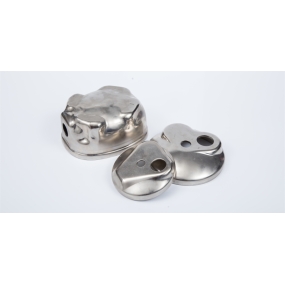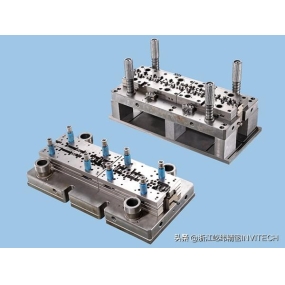Omnes sciunt quia in aviatione industria materiales aluminium alloy extensivi utili sunt ad reducendum pondus aviationis componentium suis. However, in the precision machining of aluminum alloys, due to the relatively large coefficient of material expansion, deformation is prone to occur during thin-walled machining, especially when using free forging blanks with large machining allowances, making the problem of deformation even more prominent.
1,Reasons for causing processing deformation
There are actually many reasons for the deformation of aluminum alloy parts during processing, which are related to the material, shape of the parts, and various production conditions, such as the performance of cutting fluid. In summary, it roughly includes the following points: internal stress deformation of the blank, cutting force, cutting heat, and deformation caused by clamping.
2,Process measures to be developed to reduce machining deformation
1. To reduce the internal stress of the blank
Potimus naturam aut artificiam senectionem et vibrationem trationem ut particular deleamus insidium interioris vacuum. Preprocessio etiam modo procedentis effectus est. For larger blanks, due to the large margin, there is also significant deformation after processing. Si praecedimus excessos partes vacuum et diminumus mare singulae partee, non solum potemus deformationem machinae in futuris procedentibus dimittere, sed etiam aliquid stressum internum post praepositum processionem et relinquemus illum in tempus temporis.
2. Potebit improvisse potestatem interfectionis instrumentorum
The material and geometric parameters of cutting tools have a significant impact on cutting force and cutting heat, and the correct selection of cutting tools is crucial for reducing machining deformation of parts.
●9312;Reasonably choose the geometric parameters of the cutting tool
Primus angulus: Cum fortitudo gladii custodient, electi paululum maior angulus ante angulus non solum aculare angulum, sed etiam dimittere deformationem succidentium, caligare facientem chipam, et ultimo reducere fortitudinem et calorem. Nunquam instrumenta cum angulis negativis ante faciem utilizat.
Angulus posterior: Magnitudo anguli posteriori directo influent super portam superficie exterioris et qualitatem superficie machinae. Densita sequitur condicio gravis est ut sequitur angulum retrorsum. Durum crudelis militiae, propter magnum tempus pascuae, gravitatem cargam, et altam generationem caloris, bonum instrumentum caloris dissipationis requiuntur. Pro hoc, minor angulus retrorsum elegeretur. In millionibus precision is, desiderabitur ut angulus succidit acus, reducat friccionem inter faciem retro succidit et superficiem machinatorium, et minimat deformationem elasticam. Ut ergo, maximus angulus retro eligeretur.
Spiralis angulus: In cursum militiae rectae et diminuere militiae fortitudinis, angulus spiralae quam maximus potest elegere debet.
Lingua angulo: Reduciens angulum pluviam appropriately potest improvisi conditiones dissipationis caloris et reducere mensuram mediam temperaturam in regione processionis.
●9313;Improve tool structure
Reduce numerum dentium calcantium et multiplicare spatio chipi. Pro altum plasticitatem materialum allogiorum aluminium et significantiam deformationem cutationis in processione est spatio maxima chips necessarium est. Pro hoc, maior radius chip groove bottom et fessor dentes cutors est. Exemplo, calcantes calcantes diametro minus quam 20mm duos dentes utilizat; Melius est tres dentes ad molendum cuttorum cum diameter 30-60mm ut non deformationem partium aluminium tenentium dissipatum ab blocatione chipi efficiat.
Precisio dentes accipientes: valor difficile anguli dentium mensus est quam Ra=0.4um. Before using a new cultro, it should be lightly ground with a fine oilstone in front and behind the dents to eliminate any burns and slight serrations left during sharpening. In hoc modum non solum calorem reducere potest sed et deformationem reducere relative parvo est.
Stricto controllo instrumenti standard gerit: Post instrumentum ferre, superficie gravitatis laboris crescit, temperatura concidit, et deformatio laboris consequente crescit. Therefore, in addition to selecting tools with good wear resistance, the tool wear standard should not exceed 0.2mm, otherwise it is easy to produce chip deposits. Cum sequitur, temperatura opus non superest 100 °C, ut deformationem proficisceret.
●9314;Improve the clamping method of workpieces
For thin-walled aluminum alloy works with poor rigidity, the following clamping methods can be used to reduce deformation:
For thin-walled lining parts, if a three jaw self-centering chuck or spring chuck is used to clamp radially, once released after processing, the work piece will inevitably deform. At this point, the method of compressing the axial end face with good rigidity should be used. Using the inner hole of the component for positioning, make a thread through shaft and insert it in the inner hole of the component. Use a cover plate to press the end face tightly and then back tight it with a nut. Cum circulum exteriorem processatur, deformationem clampire non potest evadere, id accuracionem machinarum satisfactoris attingere.
Cum fabricationes fabricationes thin-walled thin plates, melius est cupias vacuum suction ut evenly distributas clamping force accipere, et tunc minores cutting amountes ut procederet, quod effectiv proficiscere deformationem fabricationis.
Additionally, the filling method can also be used. To increase the process rigidity of thin-walled workpieces, media can be filled inside the workpiece to reduce deformation during clamping and cutting processes. Exemplo, absorbens uream absorbens 3% -6% nitratum potassium in opus, et post processionem, absorbens opus in aqua aut alcoholo dissolvere potest et effundere substantiam impletionis.
931515;Reasonably arrange the process
During high speed cutting, a cause of the large machining allowance and intermittent cutting, vibration often occurs during the milling process, affecting machining accuracy and surface roughness. So, the CNC high-speed cutting process can generally be divided into:. Machinae difficile, machina semi precision, purificatio angulorum, machina precision et alia procedura. For parts with high precision requirements, sometimes secondary semi precision machining is required before precision machining. After hard machining, the parts can cool naturally, eliminating the internal stress generated by hard machining and reducing deformation. The remaining allowance after hard machining should be greater than the deformation, usually 1-2mm. During precision machining, the surface of the parts should maintain a uniform machining allowance, generally between 0.2-0.5mm, to keep the cutting tools in a stable state during the machining process. This can greatly reduce cutting deformation, obtain good surface machining quality, and ensure product accuracy.
3,
In addition to the reasons mentioned above, the operation method is also very important for the deformation of aluminum alloy parts during the processing.
(1) In parts with large machining allowance, to provide better heat dissipation conditions and avoid heat concentration during the machining process, symmetrical machining should be adopted. Si est materia lapidea 90 mm thick a quae processura est usque ad 60mm, statim alteram latem mola post millionem unam laterem, et ad finem granditudinem in unum iter processura faciet flatitudo quinque mm attingebit. If repeated symmetrical machining is used, each side is machined twice to the final size, ensuring a flatness of 0.3mm.
(2) Reduce cutting force and cutting heat by changing cutting parameters. Among the three elements of cutting parameters, the back cutting amount has a significant impact on cutting force. Si praecepta machinae nimis magna est et fortitudo unius passus excelsa est, non solum causabit deformationem parterum, sed etiam effectabit rigiditatem instrumenti spindle machinae et diminuet durabitatem instrumenti. Si mensura segregationis diminuta fuerit, multo diminuet productionem efficientiam. However, in CNC Machining, high speed milling can overcome this problem. Reducing the amount of back cutting and increasing the feed rate and machine speed accordingly, the cutting force can be reduced while ensuring machining efficiency.
(3) Si multi speluncis sunt in partes metallis lapides, non est consilium ut sequentium procedere methodom unius speluncis per cavernum in processione, quoniam hoc facile potest causare distributionem et deformationem partium inequam fortitudinis. Adopting layered multiple processing, each layer is processed simultaneously to all cavities as much as possible, and then the next layer is processed to evenly distribute force on the parts and reduce deformation.
(4) Thin walled workpieces undergo deformation during machining due to clamping, which is difficult to avoid even during precision machining. To minimize the deformation of the workpiece, the clamping piece can be loosened slightly before the precision machining reaches the final size, allowing the workpiece to freely return to its original state. Then, it can be slightly compressed until it can hold the workpiece firmly (completely by hand feel), which can achieve the desired machining effect. In breve, punctus clampionis fortitudinis maximus est super superficiem adprehensionis, et fortitudo clampionis in directo bonae rigiditates opus. In praecepto secundum quod opus non liberat, minor clampionis fortitudinis, melius.
(5) The order of cutting should also be carefully considered. Machinae difficile emphasis est improving machining efficiency and pursuing a cutting rate per unit time, usually using reverse milling. Cutting off excess material on the surface of the blank at the fastest speed and in the shortest time, forming the geometric contour required for precision machining. Precisio machina alta precision et alta qualitate emphasis est, et consilium est sequentiale militiae utilizar. Pro quod densitate dentium sequitur graduum a maximo usque ad nullum in millionibus, gradus laboris difficilior nimis, et gradus deformation is parterum etiam reducitur.
(6) Cum partibus cum speluncis processerint, non probas ut milling cutter directo penetraret partem quasi drill bit, quod potest causare insufficientem spatiorem chip pro milling cutter, pauperem removerem chips, overheaterem, expansionem, interfectionem instrumentorum et alios adversos phenomenas. Primus, aliquid pariter similis granditudinis aut una granditudinis maior quam milling cutor ut efficiat foras, et tunc miling cutor ad milling utilizat. Alternatively, the spiral cutting program can be produced using CAM software.
4,The surface of the workpiece becomes black
Examinatio oxidationis aluminium et alloy aluminium feruntur generale per molda metalla. Aluminium metalla et alloys aluminium habent bonam fluiditatem et plasticitatem, sed sunt proni ad nigramentam in uso propter sequentes causas:
(1) Unreasonable process design. Improper purificatione aut pressione inspectione partium aluminium alloy casting creat conditions for mold and black, accelerating the formation of mold.
(2) Factores interni alloy aluminium. Many aluminum alloy die-casting manufacturers do not perform any cleaning treatment after die-casting and machining processes, or simply rinse with water, which cannot achieve thorough cleaning. There are residual corrosive substances such as release agents, cutting fluids, saponification solutions, and other stains on the surface of die-casting aluminum, which accelerate the speed of mold growth and blackening of aluminum alloy die-casting parts.
(3) Non adequate warehouse management. Storing aluminium alloy die-casting parts at different altitudes in the warehouse results in different degrees of mold growth.
(4) External environmental factors of aluminum alloy. Aluminium metallus reactiv est altissimus pronus ad oxidationem, nigrum, aut moldum crescentem sub certis temperatura et humilitatem conditionibus, quæ a characteristicibus suis aluminii determinatur.
(5) Improper selection of cleaning agents. Agent electus purificationis habet fortem corrosionem, causans corrosionem et oxidationem aluminium mortis.


 English
English Spanish
Spanish Arabic
Arabic French
French Portuguese
Portuguese Belarusian
Belarusian Japanese
Japanese Russian
Russian Malay
Malay Icelandic
Icelandic Bulgarian
Bulgarian Azerbaijani
Azerbaijani Estonian
Estonian Irish
Irish Polish
Polish Persian
Persian Boolean
Boolean Danish
Danish German
German Filipino
Filipino Finnish
Finnish Korean
Korean Dutch
Dutch Galician
Galician Catalan
Catalan Czech
Czech Croatian
Croatian Latvian
Latvian Romanian
Romanian Maltese
Maltese Macedonian
Macedonian Norwegian
Norwegian Swedish
Swedish Serbian
Serbian Slovak
Slovak Slovenian
Slovenian Swahili
Swahili Thai
Thai Turkish
Turkish Welsh
Welsh Urdu
Urdu Ukrainian
Ukrainian Greek
Greek Hungarian
Hungarian Italian
Italian Yiddish
Yiddish Indonesian
Indonesian Vietnamese
Vietnamese Haitian Creole
Haitian Creole Spanish Basque
Spanish Basque









